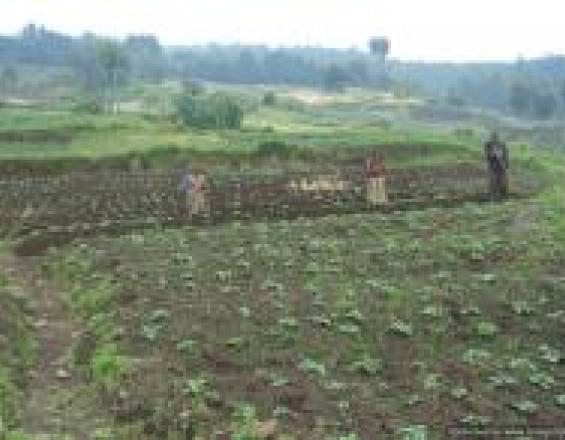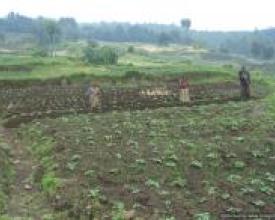Mass-media radio drama in Rwanda protects gorilla habitat

In Rwanda, Population Media Center (PMC) wrote and produced Umurage Urukwiye (“Rwanda’s Brighter Future”) in Kinyarwanda, one of Rwanda’s official languages. This 312-episode radio serial drama aired April 2007 to July 2009 and was rebroadcast October 2012 to October 2014. One of Umurage Urukwiye’s storylines role modeled the preservation of forests, natural resources, and mountain gorillas, and motivated the audience to protect and rehabilitate the park forests.
Context
Challenges addressed
In communities where obtaining food and income are daily challenges, many people do not have time to consider the long-term impacts of logging to expand farms, removing forest groundcover, and encroaching on wildlife habitats. All are considered necessary, the perception being that these are endless resources. These behaviors and their consequences to people and environment were modeled in the radio drama.
Location
Process
Summary of the process
The formative research (#1) is the foundation of any PMC drama project. The information gathered guides the writers as they create characters, settings and storylines that address issues such as habitat destruction. The writers go through extensive training in PMC's methodology to create well-written, entertaining stories dealing with complex issues (#3). Having excellent production quality (#4) ensures that the audience is fully attentive to the story, not distracted or turned off by glitches or errors. The audience forms emotional bonds with the characters, who role model knowledge, positive attitudes and behaviors (#2), creating positive peer influence on the listeners. The drama is broadcast on mass-media, either nationally or within a specific region. Adequate promotion (#5) to build regular, wide listenership across a country leads to audiences which comprise millions of people. This massive audience is being exposed to positive alternative choices, and ultimately makes those choices in their own lives, leading to a significant shift in the societal norms, attitudes, and health indicators in a country.
Building Blocks
Culturally-specific formative research
Formative research helped writers to understand where Rwandans were on the issues, enabling them to create an entertaining and believable trajectory of the characters toward the positive KAP in the drama. It includes: 1.Literature review, synthesizing the major findings of reports dealing with current cultural practices and social norms that influence attitudes and behaviors around the issues being addressed. 2.Policy framework, compiling the country’s official positions on the issues to be addressed by the serial drama including protection of gorilla habitats 3.Qualitative research explored the needs, habits, experiences, beliefs, attitudes, and behaviors of people in Rwanda with regard to the drama themes. 4.Media and Communication Analysis provided a summary of mass media and technology consumption patterns by Rwandans and a summary of the media’s impact on knowledge, beliefs, attitudes and behaviors on the drama issues. 5.Health infrastructure analysis studied availability of family planning, reproductive health and HIV prevention services. Particular focus was put to attitudes, policies, and practices of health care providers.
Enabling factors
1) A reputable and capable local research firm which uses country nationals to conduct survey. 2) Access to representative regions of the country, urban and rural. 3) Safe environment to conduct national study. 4) Funds to support the study.
Lesson learned
Lesson 1: For writers, presentation of results should not be overly technical and should provide key insights into the audience’s daily life and their attitudes, beliefs, and knowledge on the health and social issues studied. Statistics should be used sparingly and there should be plenty of relevant quotes from target audience members interviewed. Lesson 2: The formative research is often the very first task to be undertaken when a new program starts and it needs to be well synchronized with the dates established for the training workshop so that delays and rescheduling are avoided during program start-up.
Role modeling knowledge and positive attitudes and behaviors
Characters in the drama gain knowledge of issues through dialogue and dramatic situations; they model the positive attitudes and behaviors that you want the audience to adopt. Social learning theory (Albert Bandura) contends that people learn through observation (models) and may at a later time imitate the behavior they observed. Negative characters are ultimately “punished” for their negative behavior (such as trapping protected species). Characters also model self-efficacy (part of social cognitive theory) where characters come to understand their actions can produce the outcomes they desire, thus being able to persevere in the face of difficulties, particularly related to complex issues the drama addresses.
Enabling factors
1) Basic understanding of the theories by the writing team. 2) Ability of writers to incorporate the theories into compelling stories with characters role-modeling behaviors in a way that is not “preachy” and will resonate with audiences.
Lesson learned
Our urban-dwelling Rwandan-national writing team found field visits very valuable. We realized that the team needed to spend time in the countryside and forest regions to better understand the context about which they would be writing. It is essential for the writers to interview people in the target communities, especially those who are similar to the characters they have created. This provided the writers with real-life examples, people and stories to ground the story and characters in, and experience of the dialect nuances, speech patterns, and word choices of the target population. This knowledge enabled them and the actors to create a drama with characters, stories and settings that felt like a very true and relevant reflection of everyday life in Rwanda. This blending of drama with reality to comfortably address social and health issues is a crucial aspect of PMC's methodology to create shows.
Well-written, entertaining stories about complex issues
PMC serial dramas are designed using a theory-based approach to behavior change communication that enables programs to tackle complex subjects in a non-threatening and enlightening manner. PMC dramas are culturally-specific stories with “positive,” “negative,” and “transitional” characters. Issues are woven into multiple storylines. PMC creates long-running dramas that include fictional characters exhibiting different behaviors. The gradual change of transitional characters is key to the approach, and dramas show a wide spectrum of choices and the realistic consequences of different decisions. The stories must be entertaining in order to gain and keep an audience tuned in. Excellent storytelling and compelling characters lead to emotional bonds forged between audience and characters, which leads to a loyal audience and exposure to the issues, correct information and busting of misperceptions about the issues, and positive choices modeled by the characters. PMC dramas don’t include direct messages, but instead spread information and encourage discussion, self-reflection, and positive behavior change.
Enabling factors
1) Understanding of the issues, misconceptions and beliefs of the target audience (formative research). 2) Excellent writing. 3) Stories that reflect real-life situations and solutions.
Lesson learned
By making the characters, stories and settings very believable and true to life, the audience is better able to imagine themselves within the story, and hence better able to feel the effect of the positive role models and choose positive attitudes and behaviors themselves. This was PMC’s first program to integrate environmental themes and related behaviors in a major way, and we learned that such issues 1) are able to be addressed as easily as social and health issues, given appropriate technical knowledge sharing to the writers, 2) are received well by the audience, 3) give the narrative a richer context, and 4) can successfully promote positive behavior changes (such as the buying of tree seedlings and replanting trees).
Resources
Excellent production quality of drama
Well produced dramas with good music, sound effects, and excellent acting will draw listeners in and help create a large listening audience, which will in turn lead to greater impact. Poor quality production will alienate audiences, cause listeners to stop listening, and therefore result in a smaller impact.
Enabling factors
1) Easy and safe access to recording studio and transportation to studio. 2) Good audio recording and editing equipment. 3) Excellent producer/director and studio technicians. 4) Excellent actors. 5) Excellent sound effects and inviting theme music. 6) Ability to easily distribute drama to radio stations.
Lesson learned
1) We have learned that it is ideal to build and equip our own studio to ensure a high quality production and to maximize logistics of coordinating and recording with the technical and creative teams. It also allows us to have secure access to the studio when needed. 2) Recordings should be scheduled as to maximize creatives’ time; recording scenes out of order may be necessary.
Resources
Promotion
The greater the audience, the greater potential for impact. In addition to having a superb product (highly entertaining drama for social change), you must promote it to build an audience. Promotion may include launch event; radio spots; flyers; attending community events; interviews with radio stations, TV outlets, and print media; on-the-air quizzes and giveaways/contests; swag (caps, t-shirts, umbrellas, etc.) for distribution; utilizing social media, etc.
Enabling factors
1) Funds to promote this activity. 2) Staff dedicated to devising, coordinating, and completing PR plans.
Lesson learned
We have learned that it works best if the majority of the project team is involved with promotion of the drama. A large audience is crucial to driving significant levels of behavior change across the target demographic or country. An “all-hands” approach to community outreach, media engagement, and generating buzz leads to rapid audience size growth.
Impacts
The storyline follows a farmer, desperate to farm more land but without understanding of soil erosion, species protection, or sustainable farming practices. He has been cutting trees in a protected park environment where mountain gorillas live, encroaching on their environment, and ultimately causing a landslide that destroys his home. He learns that re-planting trees where he had cut them down will help prevent future disasters. By role modeling the consequences of habitat destruction, the radio drama grew awareness of how Rwandans can live in harmony with their environment. Demonstrated impacts are: 1) Post-broadcast, listeners were 3.4 times more likely to know that the protection of gorillas and their habitat can reduce poverty and bring tourists, compared to pre-broadcast survey responses. 2) The approach also led to measured changes in listeners’ actual behavior regarding their treatment of the forest environment. PMC hired an independent research firm to track tree seedling purchases resulting from listening to the program, which found that 11% of people buying tree seedlings had been motivated to do so by the radio drama.
Beneficiaries
Rwandans age 18-59 with access to radio Mountain and gorillas in Rwanda
Story
One of the storylines takes place in the fictional Tamara setting, a forested area where people live. It was intended to represent an area close to the Volcanoes National Park (where the gorillas live) which is maintained by the government as a conservation and tourist area. Please contact the solution provider for more information on this project
